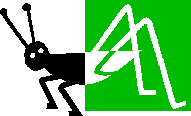
Insects:
Observing a Cricket
 |
Insects: Observing a Cricket |
|
|
MANCHESTER COLLEGE LESSON PLAN by James Vincent
Lesson: INSECTS: Observing a Cricket Length: 45 minutes Grade: Kindergarten
Academic Standard: K.2.2 Draw pictures and write words to describe objects and experiences. Academic Standard: K.3.2 Investigate that things move in different ways, such as fast, slow, etc. Academic Standard: K.4.1 Give examples of plants and animals.
Performance Objective: The student will observe & discover that insects are made up of different body parts. Performance Objective: The student will name and identify the body parts of an insect by pointing to the head, body, antennae and legs.
Assessment: Formative: students providing examples of believed insects; identifying a cricket; evaluate answers to the questions posed in Step 4. Assessment: Summative: evaluate answers given to the questions in the CLOSURE; cricket artwork.
Materials: - Magnifying glasses
- Books about insects - Paper and art supplies (markers, paints, crayons)
Procedure Introduction/Motivation: - Senses are used to observe (sight, hearing, smelling, tasting & touching). - Senses are tools that help you observe and describe. You should use more than one tool to observe, but you might not use all senses.
- Show pictures of
insects. - Today you are going to be scientists and observe a cricket. You may use your eyes, ears, noses, (and possibly hands to observe). You will also use magnifying glasses to take a closer look at the cricket.
Step-by-Step Plan: 1. Characteristics of insects:
a. They have three main parts: the head, thorax, and abdomen. e. Insects can have two sets of wings, one set of wings, or no wings at all.
- Examples of insects: flies, moths, beetles, bees, wasps, ants, ladybugs, grasshoppers, butterflies, crickets, and dragonflies. Spiders are not insects because they have 8 legs. Instead, they are called arachnids.
2. Put the children in small groups
no more than 4 children per group.
they could
describe it to a friend. Comprehension). Teacher: Walk around and monitor handling and ask different questions like: “What color is it (Knowledge)? Does it make noise (Comprehension)? Can you see different body parts (Application)? What does it feel like (Analysis)? Does it smell like anything?” (Intrapersonal; Comprehension) 5. Make sure children are observing different parts: head, wings, number of legs, antennae.
Closure: Bring class back together and ask, “What were your observations?” Scaffold questions to different students. “Do they have parts like ours (head, legs, eyes)? What were some body parts different from ours (antennae, wings)? Write observations down on the board or on a tablet. (Naturalist/Intrapersonal/Interpersonal/Logical; Knowledge/Comprehension/Application)
Have students recreate their observations by illustrating a cricket, using the paper and art materials provided.
Enrichments: Read On Beyond Bugs! All About Insects by Tish Rabe; Illustrated by Aristides Ruiz. After the reading, ask students who can name a part of a cricket and point to it on this picture? (head, legs, body, antennae, eyes) |
||
|
Return to Self-Create Works: click here. |
This site was created by James R. Vincent as a tribute to the importance of education, and as a written testimonial of the power one person can have on another.
This site was last updated 12/05/06